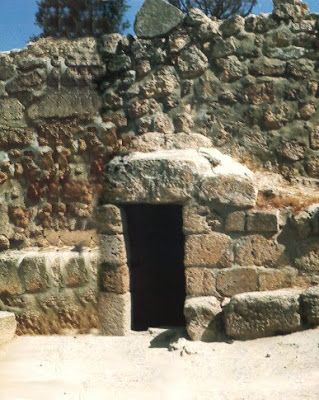
Lazarus: Raised From the Dead But Paid a Grave Price
Jesus raised three different people at three different times who died at three different ages over the course of His three year ministry. While each had its own different set of circumstances, by far the most complex of all was the raising of Lazarus. The Gospel of John only list seven miracles performed by Jesus and is the only Gospel to cite the raising of Lazarus. These miracles were selected by John to show Jesus had all power over all of creation. He could drive out demon spirits and confine them into the Pit. He could heal any mental or physical disease or deformity showing His control over the biological workings of the human body. He had the power to quiet storms and walk on water showing His control over the laws of nature. After His resurrection, He displayed the ability to instantly move from one place to another even through solid walls showing His control over time and matter. He fed five thousand by causing bread and fish to continuously replicate themselves faster than they could be consumed. He turn water into aged wine showing His control over the molecular components of matter and the ability to age matter in seconds. And finally, He showed that death, once man’s greatest fear and Satan's greatest weapon, was simply another state of being.
There is a logical reason for the omission of this miracle in the other three Gospels. John, now in his nineties, was the last Apostle to write his memoirs. By that time, Lazarus and his sisters had died. The other Gospels are now thought to have been written before 70 A.D. as they do not mention the catastrophic destruction of the Temple and the Jewish nation. So, if they had included the story of Lazarus while he was still alive, it would have made it impossible for him to escape the persecution of the Jews not only in Judah but throughout the Middle East and Mediterranean region.
In raising the dead, Jesus now reaches beyond the limits of physical life into the physical and spiritual dimensions of death, the grave and Sheol or Hell. He will now display His ability to reach into the dark, forbidding and unknown realm of the Land of the Dead where the spirits of the departed reside. There, He will extract certain spirits, bring a dead body back to life, and then re indwell that spirit back into its body thus recreating a whole living being. Neither man, nor the angels in Heaven nor Lucifer himself have the power to accomplish this feat. But Jesus did it with only His Word.
Jesus raised the dead for three reasons. First and foremost, He wanted to make it clear that He had the power to do so. This ability would be a fundamental doctrinal understanding of His ministry. That being, all people would ultimately be raised from the dead by Him through His Word, and at that time, receive their well deserved rewards. Please see related paper: "Lots of Resurrections and Lots of Raptures"
While it was clear to His disciples that He had the power to raise others from the dead, it was not at all clear to them that He could actually raise Himself from the dead. That is to say, how could He possibly while in the state of being dead, raise Himself from that state of death back to life? Simply put, how could He command Himself to arise back to life if He was dead? So, in order to make it absolutely clear that there was no circumstance that could prevent Him from raising all the dead no matter their bodily condition, He physically raised Himself from the dead on resurrection Sunday known today as Easter (John 10:18).
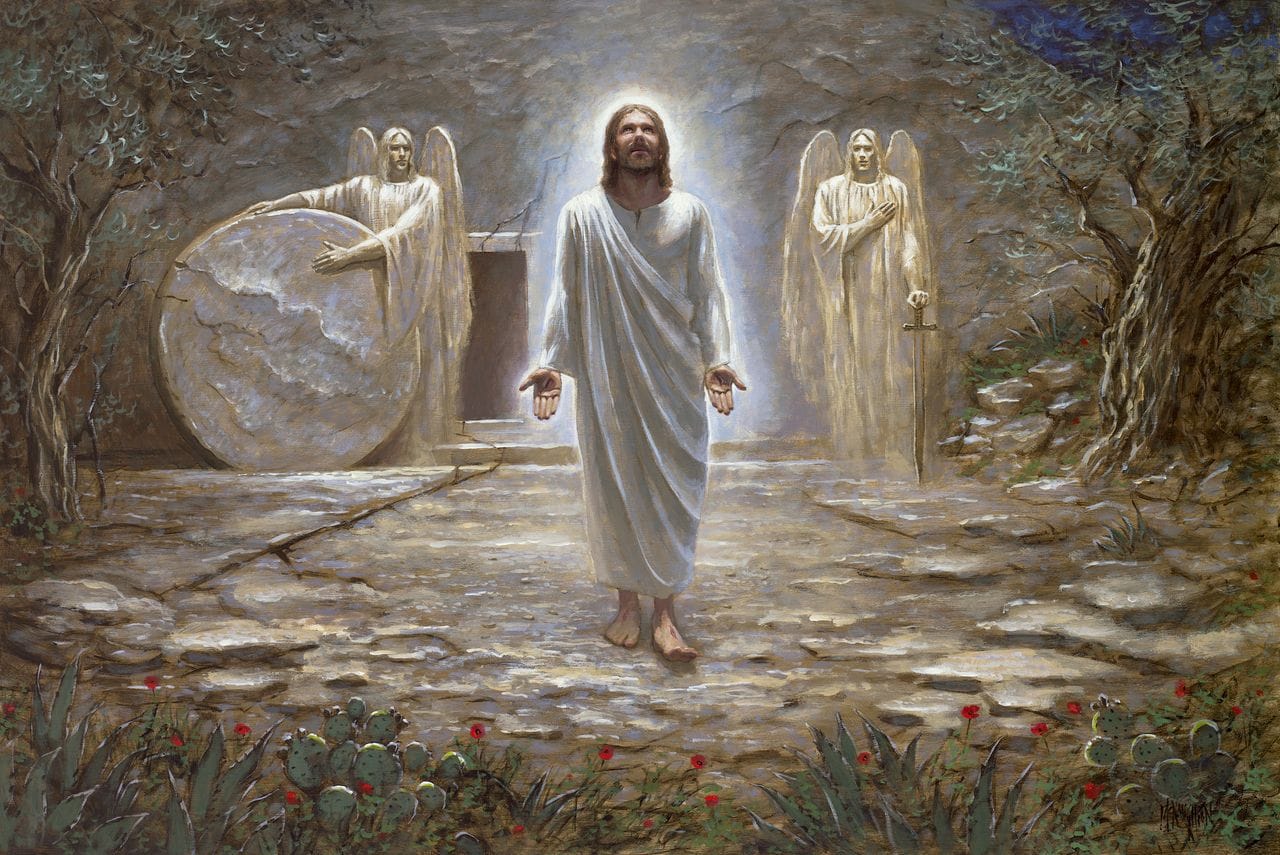
Secondly, if He could not raise Himself from being dead, why would anyone believe He could raise them from the dead. Third, He waited three days to raise Himself and four days to raise Lazareth for a reason. First century Jews believed a person’s spirit did not leave the body until the third day. So, Lazarus’ spirit would have been considered long gone by day four as his body was now in the process of putrification and could literally be smelled (John 11:39). Today, the answer as to how long a person can be clinically dead yet resuscitated varies largely on how they died. While in most cases it is four to ten minutes, in rare cases that involve hypothermic conditions, it can be as long as twenty minutes. However, in this case, both the brain and heart will have suffered irreparable damage. Fourth, Jesus raised the dead to show He had compassion on all people who experienced death and the emotional effect death has on loved ones. Jesus found the idea of children and young adults dying especially troubling. Therefore, He decidedly raised three people both male and female, of three different ages with each having been dead for various periods of time to serve as a testament that he had the power to raise all the dead.
However, He did not want to be seen during His ministry as a means to bring back loved ones from the dead on a regular basis. A request in faith from a person or a family member for a healing was one thing. But, a request to bring back a dead loved one would have to wait until the time He would commanded the two separate major resurrections of all people (Revelation 20:5-6). Until then, the sorrow death brings would continue to serve as a stark reminder to mankind that the wages or rewards for sin is death (Romans 6:23). Death also serves as a constant reminder for the need of a Savior to release mankind from the ongoing curse of sin and death that they currently find themselves trapped in.
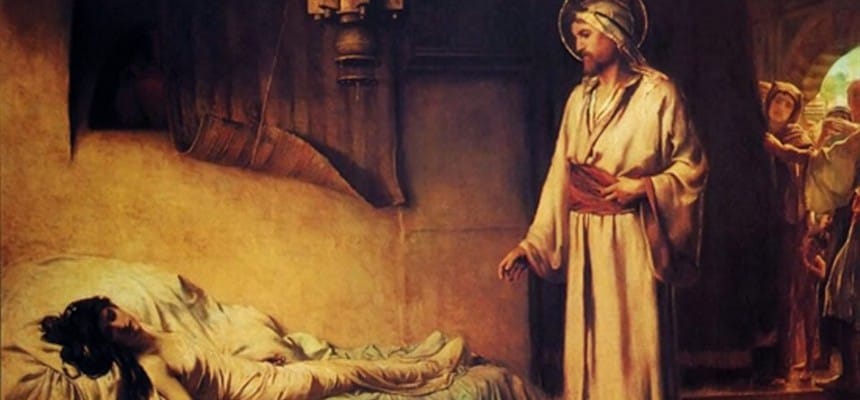
The first person Jesus brought back from the dead was a little girl who had been dead for less than an hour. He would also raise to life a young man who had been dead for a day. And finally, he would raise up His good friend Lazarus who had been dead four days. The following accounts of the first two restorations of life are compilations taken from the Gospels of Matthew, Mark, Luke and John.
It should be remembered that only Matthew and John were actually members of the original twelve disciples of Jesus (Matthew 10:1-4). Mark and Luke were devoted followers, but wrote their Gospels based on their recollections and those of eyewitnesses. Mark, also known as John Mark, is believed by scholars to have received much of his information by way of the remembrances of Peter who was his mentor. So, in some ways, the Gospel of Mark is also in part the Gospel of Peter.
Jesus had literally returned from a brief visit to the land of the Gadarenes where He exorcised over 2,000 demons from a man living in a mausoleum on the outskirts of town. Please see related: "Jesus the Demon Hunter". He then immediately sailed northwest across the Sea of Galilee back to His home in Capernaum (Mark 5: 13, 21; Luke 8:40). There He was met by a crowd waiting patiently for His return. Having left the boat, He sat down and began to preach. It was at this time that a ruler of the local synagogue named Jairus approached Him concerning a family emergency. Jesus was no doubt surprised when Jairus knelt down in front of Him before the crowd and began to publicly praise and beg Him for a favor. Jairus explained that his twelve year old daughter was now in the very last stage of dying and may very well have died as he was speaking. He said he was sure that if Jesus would only lay His hands on her, she would recover no matter her current state of health. This was a bold request as Jesus had never raised a dead person to life at this time. Jesus knew He was capable of this type miracle, but the public outcry both positive and negative would be detrimental to His ministry. He did not want the addition of bringing departed loved ones back to life to be added to the long list of requests He was already receiving. The laying on of hands Jairus requested was a recognized practice by Jewish religious leaders. However, once the person was dead, it was against Mosaic law to touch the body as it would make a person ritually unclean. Jairus was saying that he had employed every known resource to save his daughter but all had failed. Therefore, his only hope was that Jesus would use His healing powers to save his daughter and, if necessary, bring her back from the Sheol, the Land of the Dead (Matthew 9:18; Mark 5:22-24) .
Jesus stood up and went with Jairus back to his home there in Capernaum. It was while He was making His way through the crowd that a woman with an issue of blood touched Him in faith and was healed. It was because of this miracle that we have some insight as to how the Holy Spirit of God worked through Jesus. He told His disciples that He literally felt the power of the Holy Spirit discharge from His body in order to heal someone in the crowd. He immediately stopped and asked His disciples who had touched Him. It is interesting to note that the woman had most likely given birth twelve years earlier and had not fully recovered and that Jesus was on His way to cure a twelve year old girl incapable of recovering from an unknown illness (Mark 5:25-30; Luke 8:43-46). Jesus and Jairus were then approached in the street by a messenger who informed them that the child had died (Mark 5:35; Luke 8:49). The news did not affect Jesus, but He sensed that Jairus had now lost all hope. Jesus immediately told Jairus not to fear as fear was the product of a loss of faith. Instead, he must continue to have faith in His power and she would be made well (Mark 5:36; Luke 8:50). So, Jesus is telling us that faith is the vital link between the power of God and the believer. Jesus then quieted the crowd and told them not to follow Him to Jairus’ home. He took with Him into the house only the disciples Peter, James and John (Mark 5: 37; Luke 8:51).
The house was filled with a traditional array of professional mourners that were hired to conduct the Jewish burial rites. This included the playing of flutes in low minor key tones as well as professional mourners who would keep the air continuously filled with loud crying, moaning and ritual chanting (Matthew 9:23; Mark 5:38). Jesus told the gathering, “Do not cry; she is not dead, but only sleeping”(Luke 8:52). Jesus was saying that there was a great difference between what the people thought was true as opposed to what He knew to be true. They laughed at Jesus to the point of scorn. As professional mourners, they well knew what a dead body looked like. So who was He to tell them that a child who was obviously dead, was not in fact dead but only asleep. How ridiculous can one man be? ( Matthew 9:24; Mark 5:38-39; Luke 8:53)

While most people were not exactly sure who Jesus was, they did consider Him a Rabbi who deserved respect. So, when Jesus told the mourners to leave the house, they obeyed His command. Once the crowd of doubters were gone, the house was now quiet and ready for the solemnity of the event that was about to occur. Jesus now goes into the room where the body of the dead child lay accompanied by the girl’s father, mother and three of His disciples (Mark 5:40). Jesus then reached out His hand and with a powerful grip, took the girl’s hand into His own and called to her in a loud voice saying, “Talitha cumi” which is to say, Little lamb, I say to you, wake up.” (Luke 8:54) Her body immediately came alive, her spirt returned to her from Sheol and she immediately got up from her death bed (Mark 5:42; Luke 8:55). The creator of life had touched death and life was victorious. All six witnesses were profoundly astonished. Jesus then told the parents to give their daughter something to eat. He made this request for two reasons. First, for the child to eat solid food would be public proof that she was not a ghost. Second, the child had gone many days unable to eat before she died. Therefore, she needed protein in order to regain her full strength. Jesus had turned a funeral into a celebration of life!
He then told all the witnesses that they were not to tell anyone that the girl had been raised from the dead (Mark 5:43; Luke 8:56). He knew that this news would cause a series of adverse effects for His ministry. First, a riot might ensue because the dead were now alive and walking the streets of Capernaum. Second, the little girl would be seen as impure because even though she was now alive, she had been officially pronounced dead by the doctors and there was no Mosaic purification law that covered this type of occurrence. Third, the crowd would now start to beg Him to bring back their departed ones. Forth, the religious leaders would accuse Him of performing unnatural satanic acts contrary to the laws of nature. Fifth, He would be unable to leave because of the ever increasing size of the crowds surrounding the house. And last but not least, there was a real possibility that the child and her family would forever be a curiosity in the city and possibly persecuted. Therefore, this miracle needed to remain a secret at least for the time being.
The second person Jesus raised from the dead was a young man who lived in the city of Nain. Jesus had left Capernaum in the morning to travel to Nain to preach. He was accompanied by not only His disciples but a large crowd from Capernaum. The young man must have died earlier that day so that by the time Jesus and his entourage arrived, the body had been officially declared dead, embalmed in the Jewish tradition, put on a stretcher and was being carried to a burial ground (Luke 7:11).
In the first century, Jewish tradition stated that a corpse must be prepared and buried before sundown. If the family was poor, a trench was dug, the body was wrapped in sack cloth and then buried. However, if the family had the financial means, a body could be taken to a public mausoleum where it would temporarily remain for three days with a small thin cloth over the face. Each day the cloth would be inspected for any movement. If the cloth had not moved by the third day due to the effects of breathing, the person was officially declared dead and was then buried. If the person could afford a tomb, the same procedure would take place only inside the tomb. And once again, if on the third day the face cloth had not moved, the tomb was sealed. This is in part why the women came early Sunday morning, or day three, to the tomb of Jesus as they wanted to inspect the face napkin and complete the burial anointing ritual.
Jesus inquired about the circumstances surrounding the death of the dead man. He was told that tragically, it was a young man in the prime of his youth who had died. And to make matters worse, He was also told that his mother was a widow. This usually meant there would now be no way for her to support herself. This in turn meant that she may be forced to beg for food and shelter. In short, the woman was completely distraught, alone and lost (Luke 7:12). Jesus understood that the woman, through no fault of her own, had lost her husband, her only son and all hope. Jesus had compassion on her and her suffering. So He went up to her and said, “Do not cry.” (Luke 7:13)
He then walked up to the bier or stretcher which held the corpse and put up His hand to stop them from preceding to the burial grounds. No doubt the crowd was now completely silent. Since when does a young itinerant Rabbi, come up to the gates of a strange city, stop a funeral possession, tell a widow to stop mourning for the loss of her only son, then approach a ritually unclean dead body? At that moment, one could have heard a pin drop and all eyes were now focused on Jesus. Jesus then spoke a command to the corpse saying, “young man ‘I’ say to you, wake up” (Luke 7:14).
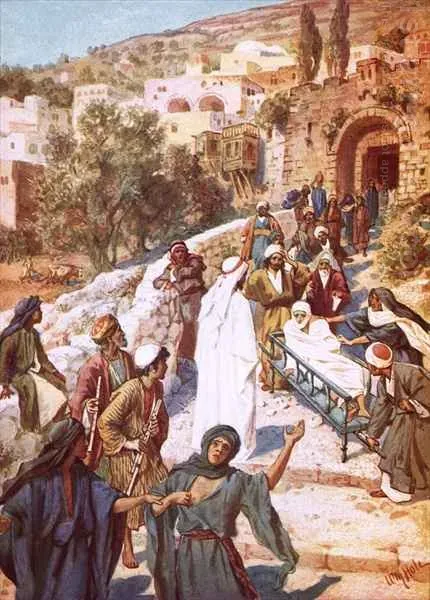
Immediately the corpse began to move under the burial wrappings. The crowd gasped and moved away from the stretcher as the young man now sat up in his burial shroud and began to speak (Luke 7:15). Scripture does not tell us what the man said but there can be little doubt that the first words out of his mouth were, ‘what is going on?’ The man would not have remembered dying in his bed as he was unconsciousness at the moment of death. As far as he knew, he passed out, went into a deep sleep and then heard an unfamiliar voice telling him to wake up. So, he awoke and sat up on what he thought was his bed in his home. Instead, he found to his great surprise that he was no longer in his bed in his house but instead at the city gates, wrapped in sheets on a stretcher surrounded by family and friends. Initially, the crowd was understandably terrified and some no doubt ran away in horror. But most apparently stayed to see what would happen next.
The first face the young man saw would have been that of Jesus standing beside him and smiling with His hand out. The pall bearers would have very quickly set down the stretcher and Jesus would have helped the young man to his feet. Meanwhile, the crowd was still in a state of shock. After all, the young man had been dead for the better part of the day. Acquaintances had paid their respects and viewed the body. But now that dead body was alive, well, walking and talking as if nothing had ever happened. However, all fear quickly turned to rejoicing when the crowd came to understand that only God could create life. Therefore, they began to praise God and recognize Jesus as a great prophet. God had been silent for over 400 years or since the time of the last Old Testament prophet Malachi who gave his prophecies in 430 B.C. But now God was obviously once again visiting His chosen people and speaking to them through the great Jewish prophet Jesus (Luke 7:16). It was this understanding of who Jesus was that spread very quickly not only throughout the entire country of Judah but also into the surrounding regions that bordered Judah.
We now come to the raising of Lazarus. Actually, the raising of Lazarus was no greater a miracle than the first two people raised from the dead. But, it was the timing of Lazarus’ death and being raised back to life that is so fascinating. It is important to remember that while Jesus raised three people, they were not resurrected. They were only raised back to life in extremely good health and most probably lived long full lives. But they all did eventually die again. They no doubt did not want to die a second time but unlike the first time, they no longer feared death having already experienced this event. This is one if not the main idea that is conveyed in these stories. If a person has faith in Christ, they should have no fear of death. It is not an event they want to experience but, at the same time, it does not cause the person to cease to exist. It is simply a transition from being mortal to becoming immortal and now living eternally. In fact today, because of modern medicine, we have more and more people being revived from what is termed as clinically dead. And all have stated that the experience was actually freeing from the every day aches and pains of the body. Those that have recollections of being dead state that they now no longer fear death. So, the process of death is not necessarily the horror that the living imagine it to be. In fact, for the righteous, it is a gentle well intentioned hand of God gently waking a person from the dull slumber of life to the exhilaration of the afterlife experience. But, what is to be considered is not the act of death but where the immortal intelligent spirit of a person goes to reside.
So, the people that Jesus raised from death all died a second time. But we can assume that their return to life made them followers of Christ. Thus, at their second death, they had no fear due to their faith in Christ and their immortal spirit went immediately to be with Him (II Corinthians 5:8). However, they were not resurrected from the dead. Christ was the first to be physically resurrected from the dead as an immortal on resurrection or Easter morning. He then spent 40 days on the Earth in an immortal state. When he ascended into Heaven on the fortieth day, His immortal body was now capable of surviving the physical journey from Earth’s atmosphere into Heaven. But, while Scripture tells us that Christ was the first fruit of the physical resurrection of the dead, He is not the only fruit. We are told in Scripture that there was a small resurrection of a few unnamed saints that occurred the evening of resurrection Sunday (Matthew 27:52-53). It is possible that these saint were resurrected immortal and are currently with Christ still in this condition. But this would be a one off occurrence. It will be at the Great Rapture of the Church that the vast majority of believers will once again spiritually indwell their resurrected immortal bodies and follow Christ to a place located off the Earth. There they will experience the Marriage Ceremony of Christ to His saints and then celebrate the reception or Marriage Supper of the Lamb. But for now, all we can state for certain is that Christ has been resurrected as an immortal and was taken to Heaven where He currently sits to the right of God the Father. Surrounding the Throne is the flame or power of God known as God the Holy Spirit (Revelation 4:5).
Before we look at the actual raising of Lazarus, we need to look at the events leading up to this miracle and why Jesus was hiding with His disciples in the Kingdom of Jordan. It would be from there He would cross back into Judah or Israel, raise Lazareth and then immediately return to another place of self-exile to wait until the week before the Feast of Passover to make His Triumphal Entrance into Jerusalem.
The last year of Jesus’ ministry was marked with continuous public confrontations with religious leaders both in villages, towns and in Jerusalem. Their pompous self-righteous attitude towards the common people was an affront to Jesus and God. And, acting as His representative on Earth, Jesus was continuously and publicly calling them out on their offences. It was clear to Jesus’s disciples that this growing hostility brought about by Jesus’ increasing animosity towards the religious leaders was a conscious effort on His part. But why? And, it was very clear to the religious leaders that Jesus was not going to go along with their corrupt practices and was not going to back down or go away. Instead, He would continue His public acts of disrespect that in turn helped Him to build a loyal following. These supporters were also of the opinion that the Temple had long been in need of a good house cleaning. But for the Temple leadership, it was clear that Jesus had become just another rebellious zealot with a myopic view of the world around Him. While past zealots had either self-destructed by losing public support or been eliminated by way of Rome or the Chief Priests working with Rome, Jesus was different.
Over a relatively short forty month period, Jesus had gone from being a poor, itinerant rural Rabbi to a highly respected charismatic leader with a following of tens of thousands of supporters. He had proven Himself through both His sermons and public debates to be a formidable Scriptural scholar, a miracle worker healing even those born blind and a prophet. It was clear to the Temple priesthood that Jesus was now in a position to wheel His power and declare Himself the Messiah. And, with public support, He would become the ruler of Israel both in civil and religious matters. While it was clear He would completely deconstruct the Temple system, it was also clear that Rome would do all in its power to keep Him from rising to the position of King of Israel. And, in the ensuing conflict, Rome would completely destroy the Temple system, the people of God and ultimately the nation. Thus, Jesus was seen as the most existential threat that the one thousand five hundred year doctrine of Judaism had ever face. The Chief Priest Caiaphas understood this when he said, it is better that one man should die than the entire nation be destroyed (John 11:50-53).

It was during the third year of His ministry that the Temple began to focus on Him and develop ways to try to reduce His public appeal. They would carefully construct questions that would force Jesus to give a blasphemous answer against Mosaic law or offend Roman law. Either way, He would find himself in trouble and His supporters would start looking for the next would be messiah to support. But Jesus would not go away. His understanding of Scripture surpassed that of the priests. In fact, while some of His answers were not orthodox understandings, they still could not be dismissed on the grounds of false doctrine. It slowly became clear that Jesus could only be removed by having Him executed. Jewish religious leaders had become so aggravated by Jesus’s answers and His rebuking the Temple system that they once literally tried to kill Him in public regardless of Roman retaliation. This had occurred many times in many places during His ministry. In fact, the religious leaders of His home town of Nazareth tried to throw Him off a high cliff overlooking the small village.
On an ominous note, the cliff not only overlooked the village of Nazareth, but it also overlooked the plains of Armageddon. However, Jesus was always able to escape an angry mob safely and undetected. This ability was both frustrating and baffling to local authorities. Doctrinal confrontations with religious leaders regularly continued up until two days before His crucifixion.
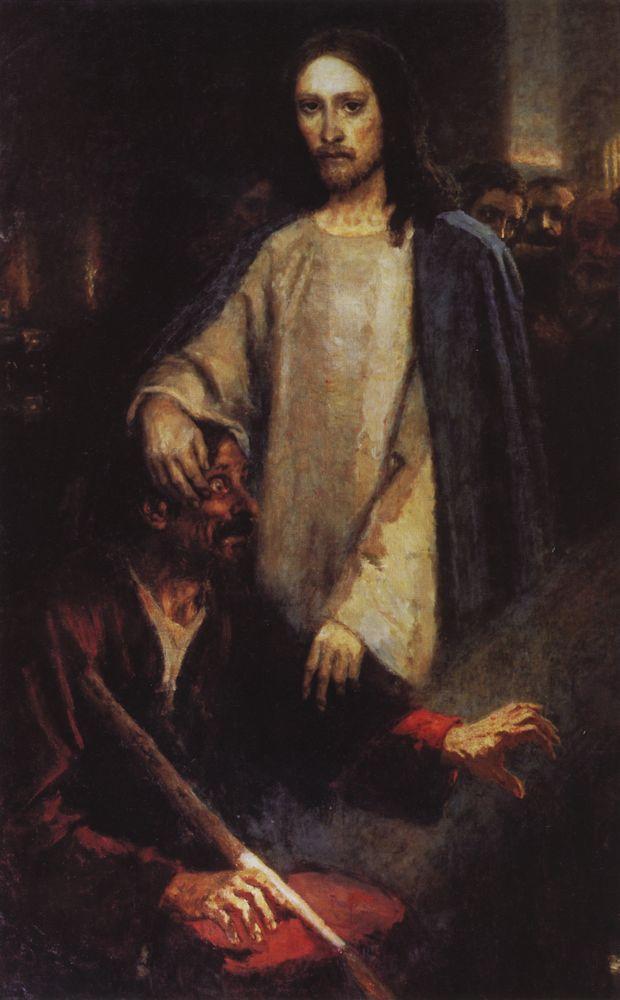
In the ninth chapter of the Gospel of John, Jesus gave sight to a man born blind. This was the first and only time in the 1,500 year history of the Jewish religion that a man born blind was given sight. As you can imagine, this caused a tremendous stir among the people including the religious leaders. The Pharisees quickly heard of this miracle as it happened in Jerusalem. They immediately held an official investigation questioning both the man who was given sight, his parents and eye witnesses. Their inescapable conclusion was that the man was born blind but now could see. After the trial, Jesus found the man and asked Him if He believed in the idea of a Son of God (John 9:35). The man said to Jesus that if He could tell him who this person was, he would believe on Him (John 9:36). Jesus then publicly said to the man, “I who gave you sight and am now talking to you is that person.” (John 9:37) The man then said, “Lord I believe and began to worship Jesus”. The Pharisees that were present, heard the conversation and were incensed. The Jews were now divided. Some said that the verifiable miracles and doctrines of Jesus must be due to the power of Satan. Others said that the power to heal could only come from the will of God. Thus, two different camps consisting of the Jewish population verses the majority of religious leaders were starting to coalesce and clash as to who Jesus was.
It was during the month of December and the Feast of Dedication or Hanukkah that Jesus was in the Temple peaching. The Jewish leaders surrounded Him and demanded that He say out loud once and for all, did He think He was the Messiah (John 10:24). Jesus answered this question by saying that they already knew who He was, but refused to admit it to themselves. To them He was an inconvenient truth. But He ended His answer by saying, “I and My Father are One” (John 10:30). The Jews became so enraged that they once again picked up stones to kill Him for the crime of blasphemy. But as they approached to take Him outside of the Temple to stone Him, He was suddenly gone from their grasp. (John 10:39).
We now read that Jesus, knowing His life was in growing danger, eventually left Judah and heading northeast, crossed the Jordan River into the safety of the Kingdom of Jordan. There He stayed in a region known as Batanea (John 10:40-42). This area is twelve miles wide and thirty miles long. It is sparsely populated as the land is not well suited for cultivation. Jesus is now about one hundred miles North East of Jerusalem and safe. It is here He will spend quality time with His disciples giving further doctrinal understandings as He prepares them for His impending crucifixion in early April and their upcoming transition from disciples or students to Apostles or teachers. However, Jesus did continue to preach and perform healing miracles in the villages of this area. Many of the people knew of Jesus through the news of His miracles. They had also heard that John the Baptizer, who they considered a great prophet, had called Jesus the Lamb of God. And, because John baptized people on the Jordanian side to the Jordan River, no doubt some of the people of Batanea were also baptized by Him. Thus, many believed what John had said about Jesus being the Messiah. Jesus was temporarily staying in this geographic area when He was located by a messenger and given news concerning the health of His close friend Lazareth. This is not the same Lazareth the beggar spoken of in Luke chapter 16 who had died before this time.
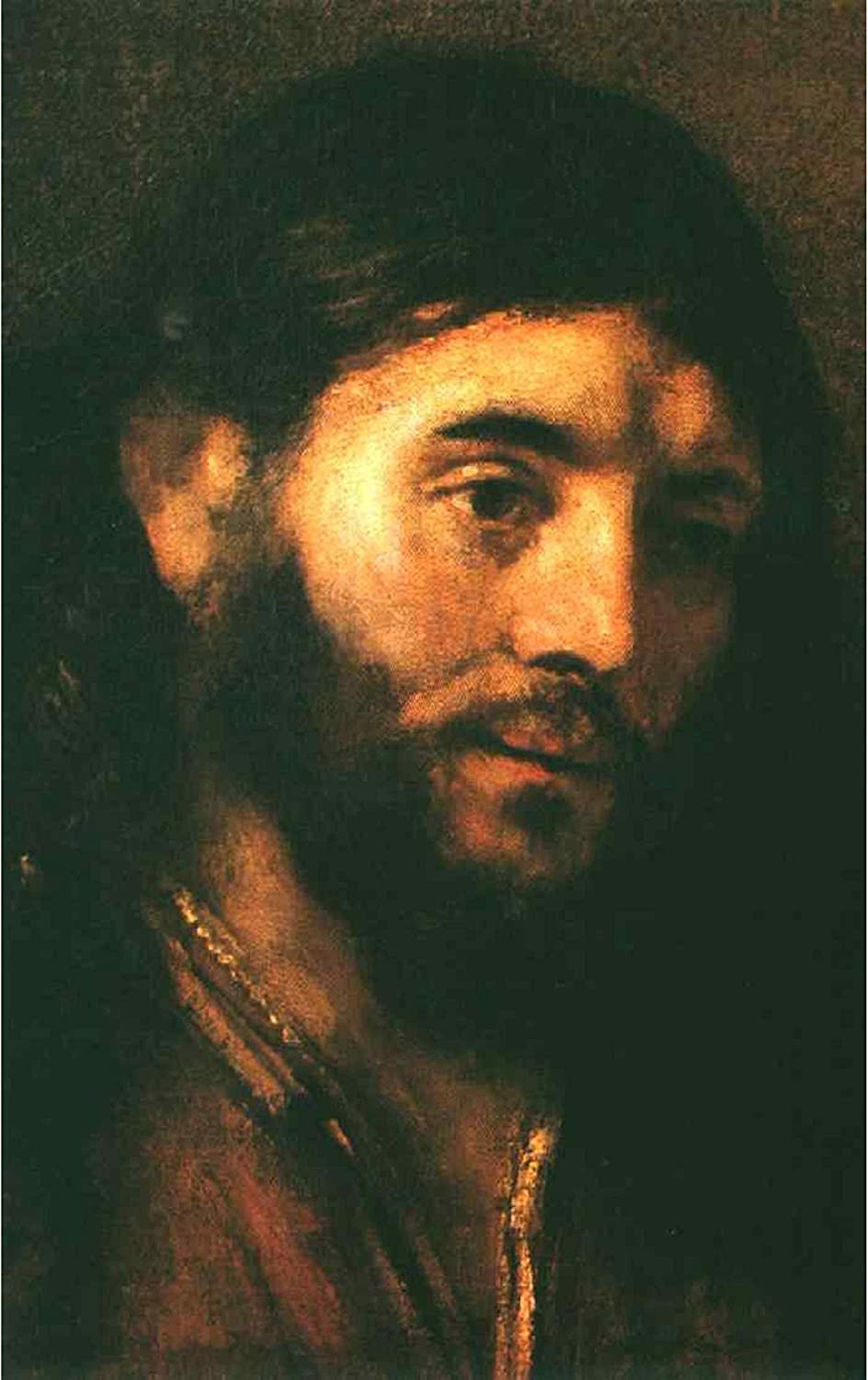
We know that Lazarus lived in the village of Bethany located three miles from Jerusalem. We know that he was only a few years younger than Jesus and had two sisters. One was named Martha and the younger one was named Mary. Some scholars believe that their father was Simon who was healed of the incurable disease of leprosy by Jesus. This relationship would explain why Jesus was having dinner at Simon’s house with Lazarus, Martha and Mary helping prepare the food (Matthew 26:6; John 12:1-3). Whether or not Simon was in fact their father, it is still clear that these four people lived in the same village, heard Jesus preach over a three year period, saw firsthand His miracles and had now become very devoted followers. He was apparently always welcomed in their homes where they would feed Him and His disciples, provide clean clothing and a comfortable mat to sleep on. Jesus is cited in Scripture as staying and having supper with them when in the area of Jerusalem (Luke 10:38-42; John 11:5). This is not to say that all twelve disciples ever stayed in a single house with Jesus. Depending on the size of the home, a few might stay with Jesus, but most would have been taken into surrounding homes to be fed and have a place to sleep. Then as now, it was customary for people of the Middle East to welcome strangers into their homes and give them shelter and food for several days. Also, Jesus along with His disciples, would have often been in Jerusalem because as healthy Jewish males, they were required by Mosaic law to attend at least three of the seven annual Jewish feasts. The three required feasts were the Feast of Passover, the Feast of Pentecost and the Feast of Sukkot or Tabernacles. The last three Fall feasts of Trumpets, Yom Kipper and Sukkot are grouped together under the name Rosh Hashanah.
We know that at the time of the raising of Lazarus, Jesus was well aware that He would be crucified the day before the upcoming Feast of Passover. Interestingly, Passover is not a sacrificial feast and it is not under the auspices of the Levitical Priesthood. It is a feast commemorating the children of Israel leaving the slavery of Egypt. The killing of a lamb was performed by the head of the household and not a priest. The blood of the lamb was put on the door post so that the Angel of Death (Satan), would recognize those under the protection of God from those who were not. So, Jesus would now serve as the actual Passover lamb prophesied for the past 1,500 years through the symbolic celebration of the Passover Feast. There is only one Jewish sacrificial feast and that is the Feast of Yom Kipper which involves two male goats. The Feast of Passover served as a shadow commemoration of the actual self-sacrifice of Jesus as the High Priest of mankind. He would sacrifice Himself in order to prevent the Angel of Death from confining the spirits of mankind in Sheol, thus eternally removed from the presence of God. The consummation of the Feast of Passover was the crucifixion of Jesus the Lamb of God. And the resurrection of Christ as the Passover Lamb, was a sign of God’s approval of His sacrifice and served as a propitiation that took away the sins of the world. The Feast of Passover has now been officially replaced in the eyes of God by the Christian rite of Communion. The wine now symbolizes the blood of Christ, and the breaking of the bread symbolizes the body of Christ sacrificed for the remission of sin in the eyes of a righteous God. Please see related paper, "Rapture Dates - Based On Feasts, A Treaty, Mathematics And Two Asteroids"
The timeline of what Jesus must accomplish over the course of the seven days leading up to Passover had been planned with the precision that can only come about through the power of the Holy Spirit. On Sunday, now known as Palm Sunday, Jesus would make a triumphant entrance into Jerusalem through the Lions Gate. On Monday He would cleansed the Temple of the money changers a second time and preach. On Tuesday He preached and was involved in heated debates with Temple priests. On Wednesday, He taught in the Temple then asked the Pharisees one scripturally based question concerning who they thought the Messiah would be. This question so confounded them that they walked away never to speak to Him again. Please see related: "Date of the Second Coming Revealed". On Wednesday afternoon, He also prophesized the destruction of Jerusalem which occurred forty years after the start of His ministry or in 70 A.D. He also gave a detailed account of the signs at the end of the age and His Second Coming. He gave this information to serve as a tribulation survival manual for the Jews of Israel and the greater gentile world (Matthew 24). Those deemed righteous by God will have been raptured off the Earth before the tribulation period. Jesus did not return to the Temple on Thursday because, as the sacrificial Lamb of God, He had allowed Himself to be inspected by the Temple Priests for the past four days. This was required by Mosaic law and He was found to be without a blemish (Exodus 12:3-6). Instead, on Thursday He would be anointed for His burial, attend His last supper with His disciples before being betrayed by one of them and arrested in a garden while praying. At day break on Friday, He would be tried seven times by religious, civil and public courts. He would be scourged twice by Rome, crucified for six hours, stabbed in the heart with a spear, buried in a borrowed tomb and arise immortal on Sunday the first day of creation and the eighth day since He entered Jerusalem. Eight is the number of a new beginning and set on its side is the symbol of eternity.
However, there were three final signs in this plan designed by God the Father that would confirm to Jesus that the timing of His crucifixion was now at hand. First, the Greeks would arrive looking to talk with Him (John 12:20-23). Second, His betrayal by Judas towards the end of the Last Supper (John 13:30-31). And third, His prayer to His Father while in the Garden of Gethsemane asking if there was any other way to accomplish the salvation of mankind other that through His crucifixion (Matthew 26:36-46). Once it was clear that there was no other way, Jesus was now reconciled to His fate. And, this final complex timeline countdown to the crucifixion and resurrection starts with a miracle involving Lazarus ten days earlier. While Lazarus’ family will play a part in this plan, Lazarus is unknowingly committed to this plan. He is committed because his involvement will require him to die.
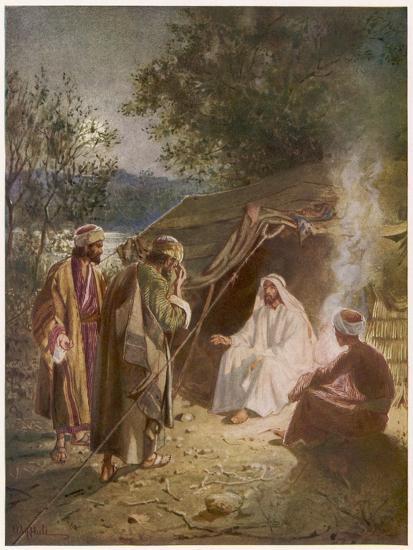
The week before Jesus makes His triumphant entry into Jerusalem, He is having a leadership retreat with twelve of His top administrative staff members east of the Jordan River in the area of Peraea (John 10:39-42). It was in this geographic area directly across the river from the city of Jericho that John the Baptist preached. John prophesied of the coming Messiah and baptized people, including Jesus which was the official start of His ministry. Jesus apparently had been informed by the Holy Spirit that Lazarus had become sick and died. This does not mean that God caused Lazarus to become sick and die. God does not causes bad things to happen to people. Bad thing happen to people because they are habitual sinners. However, God can and does regularly step in to stop bad things from happening to people at certain times. And, He can use bad events to further His plans. Sadly, if a righteous God were to step in and stop all bad things from happening to all of sinful mankind, the world would stop turning to God and simply go on sinning in the belief there are no consequences. And if there is one major issue that currently causes the majority of problems in the world today, it is that there are little or no consequences for bad behavior! However, God’s ability to use bad events to bring about good results is just one of many ways God is continually irritating and defeating the plans of Satan to completely destroy mankind.
As Lazarus lay dying in his home in Bethany, His sisters immediately sent a messenger to Jesus saying that they needed His help because their bother’s health was getting worse by the day and he was destined to die without Jesus's healing powers (John 11:1-4). Obviously Jesus must have previously sent a message to the family explaining He was currently wanted by angry mobs at the Temple. Therefore, He was going to cross the Jordan River with His disciples in order to stay in a certain wilderness area until the time came for His return. Scripture does not tell us if Jesus knew in advance that Lazarus was destined to get sick and die at that time. But it is more than coincidental that He informed the family where He could be found while in hiding. We do know Jesus was notified by the Holy Spirit that Lazarus had died before the messenger arrived, and that Jesus was now to go and raise Him from the dead as a public show of His power over death. So, when the messenger located Jesus and told Him Lazarus was sick, Jesus said out loud to His disciples, “He shall not fall prey to death, but for the Glory of God, that the Son of God might be glorified thereby {also}” (John 11:4). A more accurate translation of this verse is, “This sickness will not end in death” as opposed to the popular translation, “This sickness is not unto death” implying Lazarus did not die. For clearly we read that He did die and was buried. So the verse is saying that Lazarus will die but will not remain dead. Also, that the act of raising Lazarus would be for the Glory of God and also His only begotten human Son Jesus.
Then Scripture simply adds the phrase, Jesus loved Martha and her sister Mary and Lazarus. This must have been included to further explain that nothing is impossible for Jesus to do on behalf of those who love Him. He first loved them even in their sins, and they as believers now love Him therefore, physical death has no permanent hold over them. This verse also explains that Jesus loves all people and those that love Him in return will not experience permanent physical death any more than Lazarus experienced permanent physical death. We then learn that Jesus stayed where He was for two more full days (John 11:6). So, while the messenger told Jesus Lazarus was very sick, Jesus knew Lazarus had died and yet decided to wait a few more days before coming to visit the family. The timeline is as follows.
Martha and Mary can see that Lazarus is on the brink of death. They send a messenger to a place where Jesus had told them He could be found. If He was staying east of Jericho, it would have been a one day walk to locate Him. The messenger told Jesus that Lazarus was very sick but Jesus knew he had died earlier that same day. Then Jesus waits two days before He announces to His disciples that they are going to Bethany. The village is a one day walk from where they are and only three miles from Jerusalem. Thus, when they arrived, Lazarus had been dead four days.
The disciples had mixed emotions about His announcement to leave the safety of Jordan. They wanted to return to their homeland and to attend Passover which would occur in less than two weeks (John 11:8). But, at the same time, they knew that the religious leaders probably had an arrest warrant out for Jesus and possible them as well. They also remembered that Jesus had told them on three different occasions that He would soon be crucified in Jerusalem. But Jesus explained to them that they could not continue to stay in hiding from the authorities as His mission from God was to spread the light of the Gospel or good news. On an interesting note, Jesus explains this by saying that if a man walks twelve hours in the light he does not stumble, but if he continues to walk another twelve hours now in the dark, he will stumble (John 11:9-10). This is a veiled revelation by Jesus that the Earth rotates around the sun as opposed to the sun rotating around the Earth. This theory would not be understood until Nicolaus Copernicus presented his theory in 1543. And even then it took another century for this understanding to be accepted.
Jesus tells them they must go because, “Our friend Lazarus sleeps.” (John 11:11) Interestingly, the word sleep is derived from the Greek word cemetery. And, since the body of a Christian is destined to be resurrected, it is not to be considered so much as dead but more in a state of resting until it is awakened to eternal life. This is why many Christian grave markers say, Rest in Peace. However, the disciples replied to Jesus that if Lazarus was sick and resting, should he not be left to sleep and not be awakened? It was then that Jesus told them plainly that “Lazarus is dead” (John 11:14). Then Jesus said that He was glad for their sakes that He was not there with Lazareth because they were now about to receive a lesson about the power of faith. This coming experience should have served to uplift their spirits and give them hope during His crucifixion and burial (John 11:15) . But Thomas, who had resigned himself to being killed with Jesus when they returned to Jerusalem said, “Let us also go that we may die with Him.” (John 11:16) Meaning, if the mobs of Jerusalem are going to kill Jesus, let us all die together with Him.
We can rightfully imagine that Judas must have begun to experience a full blown panic attack upon hearing this dire scenario. We will soon learn through his actions that he was not remotely supportive of this idea of dying with or for Jesus. Instead, He was of the opinion that either he or Jesus must do something so that the religious leaders did not kill all of them. It was then that he began to work on what he considered a fool proof plan that would force Jesus’ hand with the authorities and that the outcome would benefit him one way of the other. Please see related paper, "Why Did Judas Betray Jesus"
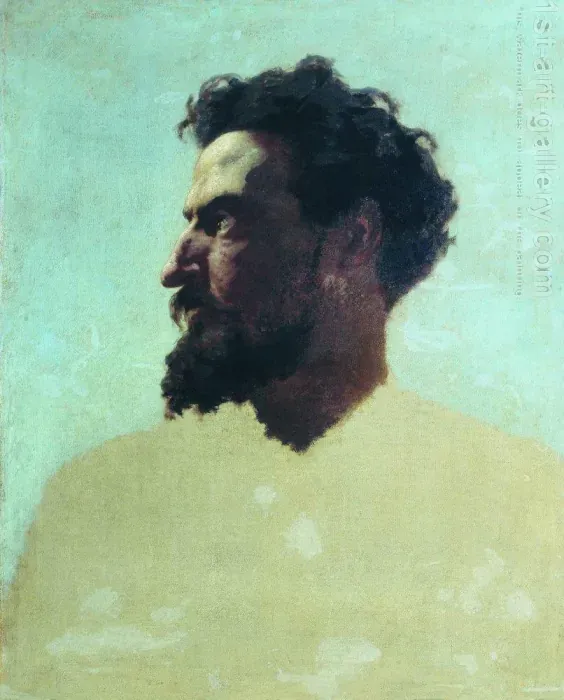
We know that when Jesus and His disciples arrived in Bethany, they were told that Lazarus had been in his tomb four days and was now decomposing (John 11:17). By this time, the family’s friends were in the process of visiting Martha and Mary to pay their condolences (John 11:19). Wherever Jesus went, the news of His arrival spread very quickly. There were many who wanted to meet and hear Him and many desperate to be healed. Jesus apparently sent a person ahead to tell Martha and Mary He had come to see them. He understood it was best to meet with them outside the village of Bethany. He did this for two reasons. First, if He arrived at the village, the house would quickly be overrun with people wanting to meet with Him. Second, the village was three miles from Jerusalem and Jesus only wanted to accomplish God’s will concerning Lazarus and then return back to the safety of the wilderness. He knew God's time plan was for Him to arrive in Jerusalem on Sunday which was six days before the beginning of Passover. Six is the biblical number of mankind. Martha got up and went out to meet with Him while Mary stayed seated and continued to greet visitors as she waited for her return (John 11:20).
During the first century, the Rabbi’s believed that the spirit of a dead person wandered around their grave for three days. It was referred to as the Days of Weeping as the spirit was seeking a way to re indwell its body. On day four, decomposition would set in and the spirit would leave the grave area. It was then that mourners would beat their chests and cry loudly for four more days. Thus mourning for a total of seven days (Genesis 27:41). On day seven, the family would come to the grave site while the mourners would line up in a long row. The family would pay their final respects to the deceased then, as the family returned to their home, each mourner would speak words of comfort to them as they passed by. Jewish tradition also required that the family of the deceased was to be in a seated position in their homes when receiving the condolences of friends. So, this was the situation with Martha and Mary when news came that Jesus was waiting outside at a certain location to meet with them. Martha broke with this tradition as a sign of respects and went to Jesus instead of having Him come to her.

Martha greeted Jesus by saying that she was sure if He had been there four days earlier when Lazarus was sick yet alive, He would have healed him. But, she went on to say that she knew for sure that whatever He asked of God, God would give it to Him. She knew this because while Jesus had raised the little girl in private, He brought back the young man from the dead in front of a large crowd. So, His power to raise the dead was now known, and Martha wanted Him to use that same power to bring back her brother Lazarus. Jesus knew that she had some faith in Him, but more important, He knew that the faith Lazarus had in Him had been strong. Therefore, He immediately put her fears to rest by simply saying, “Your brother shall rise.” (John 11:21-23) The word again usually found in this verse is not in the oldest Greek texts. Then Martha says something remarkable that shows a fundamental lack of understanding as to who Jesus was. She said to Jesus, “I know that he will rise again in the Resurrection of the last day.” (John 11:24) This shows several precepts about the belief system of Martha at that time. First, she held a belief as taught by the Pharisees of an afterlife of the dead. She also knew this was probably true as Jesus had stated this publicly to the religious leaders (Matthew 22:29-34). This public revelation by Jesus only further soured His relationship with the Sadducees as they did not believe in an afterlife, nor angels, nor rewards from God. This is why they were sad-you-see? She had also probably learned this concept from the Book of Job as this is one of the few books in the Old Testament that spoke of an afterlife along with the Book of Daniel (Job 19:25-27; Daniel 12: 1-3, 13). She may also have heard Jesus speak of the regeneration of the world (Matthew 19:28). But Jesus never spoke directly on the resurrection and rapture at the end of the Church Age. Instead, Jesus revealed these events almost exclusively to Saul of Tarsus {Paul}. So, Martha was taking solace in the understanding that at the end of the age of the rule of mankind, God would resurrect all the dead and they would stand trial for their actions. Then, some would go into everlasting glory and some into everlasting condemnation. This is a truncated and twisted Jewish version of what we now know as Christians to be true. That is, there will be a great resurrection and rapture of the saints of Christ the Messiah and all those deemed righteous by God. This event will be followed by seven years of tribulation ending in the Second Coming of Christ. At the end of His one thousand year Reign on Earth, there will be a Great White Throne Judgement of God (Revelation 20:11-12). This judgement will only involve those currently in Sheol who adamantly refuse to accept the offer by God of grace and mercy through Christ.
So, this belief of Martha’s concerning a resurrection at the end of the age was traditionally held by those Jews who believed what the Pharisees taught. This gave Jesus the perfect opportunity to plainly state out loud who He was, and His part in the resurrection and eternal life of mankind. Jesus then said to her, “I am the Resurrection and the Life.”(John 11:25) The words “I am” have a tremendous double meaning. Jesus is referring to Himself while at the same time inferring that He is the physical incarnation of God whose name is I Am (Exodus 3:14). Also, the Greek word resurrection demands an emphasis on physical death and physical life restored. It does not refer to the death of the intelligent spirit as the spirit of all people is already eternal. So Jesus starts off by saying that there can be no resurrection except through Him.
Jesus then states, “... he who ‘believes’ in Me, though he were dead, yet shall he live.” (John 11:25; I Thessalonians 4:13-18) This is a direct reference by Jesus to the resurrection of believers who have died. Those who are dead at the time of the rapture, will first have their bodies resurrected as immortal and arise from their graves into the atmosphere of the Earth there to be re indwelled with their eternal intelligent spirits. Then they will follow Christ to a place where they will participate in His marriage to His Church followed by a dinner reception (John 14:3; Revelation 19:6-9). They will later return to Earth with Christ at His Second Coming to assist Him in His Millennial Reign.
Then Jesus said, “And whoever lives and believes in Me, shall never die” (John 11:26). Jesus is plainly stating that any resurrection at any time is impossible without His involvement. Real life both physical or spiritual, mortal or immortal comes only through faith in Him. Jesus is now also talking directly to those believers who are alive at the time of the Rapture. For them, their bodies will instantly become immortal and they too will ascend into the heavens to be with Christ. thus they will never experience death. These two separate events of the raising of the dead and translation of the living to immortality will occur almost simultaneously. And their joint ascensions will occur in the "blink of an eye" which is to say a nano second or quicker than the human eye can physically register this event. Thus, they will seem to disappear without a trace when in fact they are simply moving at the speed of thought. One may ask, why does the ascension need to take place so quickly. The answer is simple, tearful goodbyes would only make the journey harder still.
Jesus then asks Martha the question all people must ask themselves, “Do you believe this?” (John 11:26) Martha answers as best as a person could not fully understanding that Jesus is God incarnate. This understanding then and now is incredibly difficult for any person of any religion to understand and except. But Martha answers Jesus’ question and says, “Yes, Lord: I believe that you are the Messiah or the Anointed Son of God, which should come into the world.” (John 11:27) The term Son of God was first used by the Angel Gabriel when he told Mary that her Son was to be called the Son of God (Luke 1:35). John the Baptizer called Jesus the Son of God (John 1:34). Nathanael called Jesus the Son of God (John 1:49). Peter called Jesus the Son of God ( Matthew 16:15-17). And, the Roman Centurion called Jesus the Son of God (John 27:54; Mark 15:39). Jesus was the Son of Man as He was born of Mary in the direct lineage of King David. But He was also the Son of God as God the Father was His biological Father (Luke 1:35).
Martha then leaves Jesus and goes back home to tell Mary that the “Master” or Rabbi has arrived and wants to also meet with her privately. She immediately got up and “came to Him” which implies that the area they were meeting in was outdoor in a location away from public view. Scripture tells us that Jesus had still not yet come into the village but waited in the place where Martha had met Him (John 11:28-30). Martha and now Mary had apparently left their home filled with mourners who thought that the two sisters had become so grief stricken that they were returning to Lazarus’ tomb to morn in private. So, they decided to show their emotional support by following them (John 11:31). This was all part of the traditional Jewish seven day mourning period for the recently departed (Talmud, Moed Qatan 27b).
Martha and Mary are practically running to the tomb while the mourners are walking behind them. Mary ran up to Jesus, fell at His feet and blurted out the frustration that she had been dealing with since she sent the messenger to locate Jesus. She said, “…Lord, ‘if' You had been here, my brother would not have died.” (John 11:32) Never have truer words been spoken as no one dies in the presence of God. But man has separated Himself from God through sin and now has to reckon with death.
Jesus stood there with Mary crying at His feet, Martha sobbing by His side, a crowd of approaching mourners all weeping and the stench of death in the air. Scripture tells us that as Jesus surveyed this sight, “… He groaned in the spirit and was troubled.” The word groaned means to be emotionally moved. Jesus spoke creation into existence to live not to die. God hates death as it is unnatural and was not part of His original plan for mankind. Man and nature both now groan because of a sin filled world and a deep desire to return back to the Garden and the presence of God their Creator (II Corinthians 5:8; Romans 8:22, 26).
Jesus then asks them to accompany Him to the tomb. There Jesus contemplates, in one single moment in time, the incredible magnitude of the downfall of mankind from the garden, to this moment and His own impending crucifixion and burial. It is emotionally overwhelming to the point that, “Jesus wept.” (John 11:35) He wept for Lazarus whose spirit would now be removed from Sheol or Paradise and brought back to Bethany only to die a second time. He wept that Lazarus would soon become a hunted man by the Jewish religious leaders for the rest of his life. He wept for all the sorrow that death brings to a family, friends and a community. He wept because death now came to seven out of ten children while in childhood. He wept for the billions of those who had died because of sin since Adam and the billions that would die before the end of the age. He wept because while He had brought the promised Kingdom of God to the Jewish nation, their leaders were at that very moment conspiring to have Him executed using the authority of pagan Rome. And He wept because of the coming wrath of God that would cause the complete destruction of His chosen people, their capitol Jerusalem and their God ordained nation. What a horrible, hopeless, cynical state of being mankind now finds itself in with no comprehension of the sorrow it brings to its Creator. And, there was no way to break this cycle except through the torturous death of the Creator by His creations as a propitiation for their sins.
The Jews standing quietly and witnessing this scene whispered among themselves. They wondered as did Lazarus’ family, why did this Rabbi of miracles not save His close friend? (John 11:33-37) Jesus now approaches the tomb that had been cut out of rock with a stone placed over the entrance. Jesus said for them to take away the stone. Martha quickly reminded Jesus that Lazareth had been dead four days and therefore a tremendous foul odor would be released and dive all the mourners from the site (John 11: 37-39). Jesus reminded her of what He had just said to her minutes earlier. Those who have faith in Him will never die and that she heard and had agreed to this understanding (John 11:26-27). But Martha was obviously still of the belief that they were talking about a resurrection at the end of the age and not at that moment.
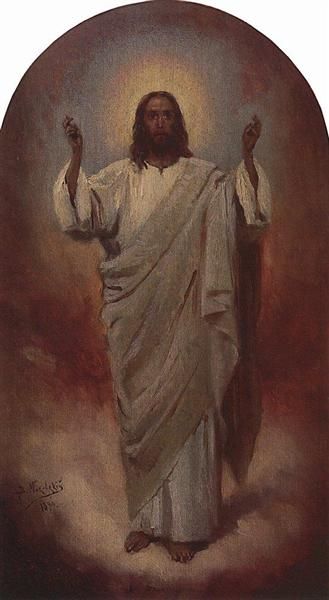
Some of the mourners removed the stone from the tomb. Jesus then lifted up His eyes to Heaven and said out loud for all those present to hear, “Father, I thank You that You have heard Me” (John 11:42). Jesus is speaking in the past tense. This is because Jesus knew not only the exact moment Lazarus died, but He was told at that time by God that He was to go to his the grave and publicly raise Him. And that He would do this while only three miles from Jerusalem and only ten days till the Feast of Passover. Therefore, Jesus was thanking God publicly for the raising of Lazareth which had been ordered four days earlier. Jesus then says in effect, And ‘I’ know that You always hear Me when I talk to you both in My mind and when I talk to You out loud in public. But I am now speaking to You out loud so that all those who are standing here will know for certain that You, the God of Israel have sent Me (John 11:41-42).
Jesus had three reasons for making this public announcement. First, He wanted the people to understand that His ability to raise the dead did not come from Satan the Angel of Death as some of the religious leaders believed. This ability came from God the Father Creator of life. Secondly, He wanted to publicly prove His ability to keep His promise to His followers concerning their resurrection from the dead. And last but not least, He wanted to provide proof of the temporary nature of death. So now, in broad daylight and in front of a crowd, He would prove once and for all that only He had the power to raise a rotting corpse from the dead.
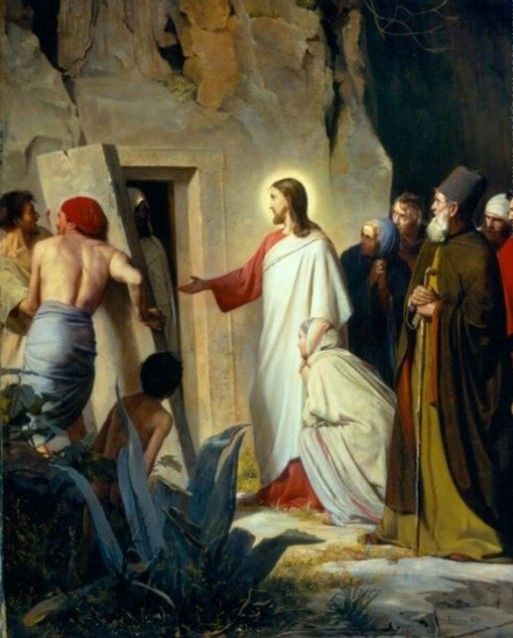
Jesus lowered His gaze from the sky to the opening in the tomb. He then yelled in a loud clear voice for all to hear the command, “Lazarus, come forth” (John 11:43). He specifically called out Lazarus’ name because if He had not done so, all the bodies contained in the tomb would have arisen and come out. However, we now know that it will be this voice giving this command that will be heard by the faithful at the resurrection and rapture of the Church. At that time, all believers will come forth out of their graves and then arise up into the heavens. It was upon this command that Lazarus immediately came to life while lying on a stone shelf in the tomb. He took a deep breath, opened His eyes, immediately sat up, saw the light coming from the doorway and began to walk towards it. He was not weak or struggling as He was now in a state of perfect health. He was also capable of walking as Jews did not embalm their dead as did the Egyptians. Instead, they wrapped the arms and legs separate from the torsos. Please see related paper, "Timeline Of The Resurrection". So Lazarus was not restricted in movement and had no trouble walking out of the tomb.
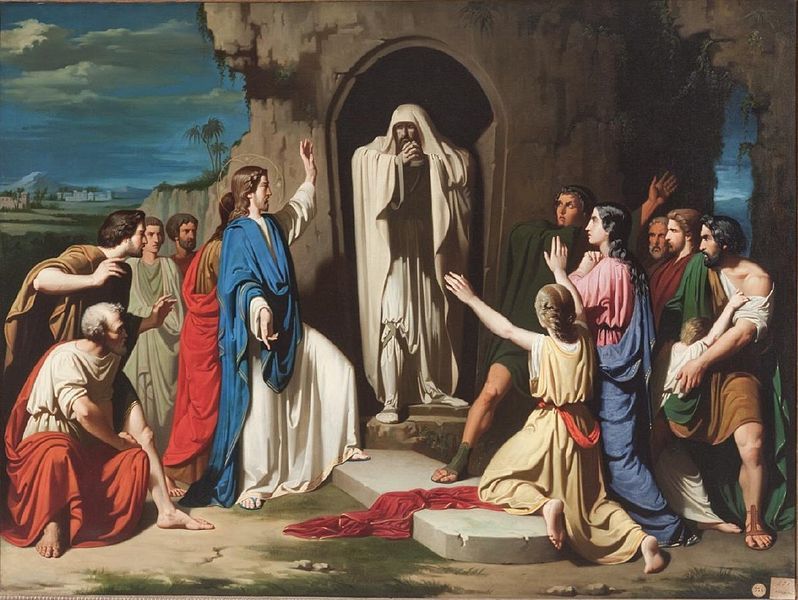
Lazarus suddenly appeared in the dark entrance of the tomb, then stepped outside into the sunlight. He was wearing his burial wrappings and what is referred to as a Face Napkin. This is actually a second piece of cloth that is placed under the Jaw and tied at the top in order to keep the mouth closed. Lazarus would not have noticed that he had this cloth on his head. He was no doubt as stunned as to what was going as were the onlookers in front of him. He was no doubt trying to figure out where he was, how he got there and whose bright idea it was to bury him alive? But the crowd could not clearly see his face due to the face cloth, so they did not know for sure it was Lazarus. And, no one was immediately eager to run up to a man who had been dead for the past four days and touch him. Jesus broke the awkward silences by commanding that someone please remove the cloth and loosen the body wrappings so that Lazarus could return to his home and continue on with his life. Literally, Lazarus needed to have his burial wrappings removed. Spiritually, Sheol had given up or had removed one of its dead. Prophetically, this is the exact same command the faithful, both dead and alive, will hear from Christ and this is exactly what will happen to them. They will suddenly hear His voice saying, "Come up!" They will take a deep breath, open their eyes, look up, and instantly ascend into the sky moving directly towards the bright light of Christ. Thus, Lazarus is a shadow of the actual future resurrection event to take place on a worldwide scale. This will cause the start of the seven year Tribulation Period.
As is to be expected, there have been and always will be sceptics concerning the powers of Christ. Many of the Jews who witnessed the miracle of Lazarus believed. But some did not believe and immediately went back to Jerusalem to report to the religious leaders the disgraceful and unnatural display that Jesus had the audacity to perform in the Temple’s own back yard (John 11:44-46). The Chief Priests and Council of the sect of the Pharisees immediately met once again to decided what to do with a man that was constantly performing miracles that in turn cause more and more people to follow Him. They were concerned that if they just continued to ignore Him, the majority of the nation would eventually come to believe He was in fact the Messiah. Then Rome would react by destroying their religion which meant that they would lose their positions of authority and the Jewish nation would cease to exist (John 11:45-48). The High Priest Caiaphas was present and stated that obviously there was only one solution in order to save lives, the Jewish religion and the Jewish nation. Jesus must die! (John 11: 49-51)

The position of High Priest was appointed by the reigning Roman governor. The three High Priests before Caiaphas and the one after Caiaphas had only held the office for one year each. Caiaphas had obviously proven himself to be very politically savvy and thus was able to remain High Priest for an astounding 18 years (18 A.D.-36 A.D.) He even married the previous High Priests’ daughter to seal the position in his favor. John then reveals to us that although Caiaphas saw the death of Jesus as the quickest most convenient solution to the problem, it would be the biggest miscalculation of his life and lead to the total destruction of the nation of Israel for two thousand years.
Caiaphas, through his decision to execute Jesus, had unknowingly and personally chosen Jesus to be his Passover sacrifice lamb for that year. He also, as High Priest, had chosen Jesus as the Passover sacrifice for the nation of Judah when he stated, it is better for ‘us’ that one man must die {be sacrificed} for the Jewish people than the entire nation be destroyed (John 11:50). John then tells us that, "Caiaphas was not speaking just for himself but as High Priest he was prophesying that Jesus must die on behalf of the nation" (John 11:51). But in reality, Jesus would not die only as the Passover sacrifice for Caiaphas and the Jewish nation. His death would seal in blood a more perfect covenant that offers all mankind the opportunity to receive eternal salvation. Jesus was in fact the universal Messiah of the World that would bring all of God’s children into a personal relationship with their Creator (John 11:52).
The decree of death from the High Priest concerning Jesus was accepted by the Chief Priests of the Temple. Now it was only how to build a legal capital offence case against Jesus, arrest Him and have Him executed without the Temple authorities shouldering any of the blame (John 11:53). Jesus was well aware of the murderous plans of the Temple’s Chief Priests. He probably only stayed with Lazarus, Martha and Mary for an hour or so as He knew that the Temple would be sending guards to arrest Him for questioning. So, He said good bye and then traveled to a city called Ephraim about fifteen miles northeast of Jerusalem but near the edge of the wilderness (John 11:54). He would wait there until it was time for Him to enter Jerusalem for the last time. And, should the Temple send guards to arrest Him, He could quickly escape into the wilderness. It was in Ephraim that He continued to meet privately and exclusively with His disciples. We now read that the Passover was "very near". The Jewish pilgrims from around the Mediterranean region had begun to arrive in Jerusalem and wondered if and when Jesus would appear. Over the past three years they had grown accustomed to listening to His sermons and hearing firsthand of His miracles. He had garnered Superstar status during the feast dates. Even more on their minds, was Jesus in fact the Messiah and if so, when would He make himself know as such (John 11:55-56). On the other hand, the Temple Priests and Pharisees had a standing order that if any member of these groups were to see Jesus, they were to immediately report the sighting so that He could be followed, and at the appropriate time, arrested and tried.
Scripture tells us that after Lazarus was raised from the dead, he went back to his home, but his life had dramatically changed. He was now a celebrity as news of this tremendous miracle had quickly spread throughout Judah and the area. So, when the Jews traveled to Jerusalem for Passover and the other six annual feasts, they made it a point to come by the House of Lazarus. There they could talk with him and hear the story firsthand. And no doubt Lazareth was more than happy to explain the event to them in great detail. This also gave Lazareth the perfect opportunity to tell both Jew and gentile the good news or Gospel of Jesus as Messiah. Lazareth had, unbeknownst to him and his sisters, started a ministry. And this immediately caught the attention of the Temple’s Chief Priests. Jewish pilgrims were coming to see Lazarus and walking away believing that Jesus was in fact the Messiah. Thus, Lazarus and his family were now in mortal danger. The Chief Priests were now plotting how to kill both Jesus, Lazareth and possible his two sisters (John 12: 9-11).
We do not know when Lazarus decided to leave the village of Bethany in Judah. But we do know from Scripture that while the Chief Priests were plotting to have Jesus killed, they heard of the raising of Lazarus and the growing crowds lining up to meet Him and to learn more about Jesus. This means that Jesus had not yet been crucified. So the time between the raising of Lazarus and the crucifixion must have been less than two weeks. Thus, Lazarus was now worrying about being killed by assassins perhaps only a week after he had been brought back to life. Then, with the death and spectacular resurrection of Christ less than two weeks after he was raised from the dead, Lazarus knew that the time for him to flee had come. The fact that Jesus was now an immortal and meeting secretly with His disciples in various locations for another forty days did not help a mortal Lazareth stuck in Bethany only three miles from the Temple. And, just as Christ apparently only met with His followers after He was resurrected, Lazareth came to realize that he too was only safe in his house and in the company of friends and family. It was then he decided it would be best not to tempt death a second time and leave the country of Judah to start a new life in a new land.
We have two different oral traditions that explain how he and is sisters left Bethany in Judah and where they went. The first version states that the Temple's Chief Priests placed Lazarus and his two sisters in a boat far out in the Mediterranean Sea and set it adrift with no sails and no ores. This would at first appear to be a death sentence, but with God, all things are possible. They drifted and eventually made land in Provence, France. This is a formidable 2,600 mile trip over land and only a little shorter by sea. From there they found their way to Marseille where Lazarus began a ministry converting pagans to Christianity. He and or his sisters are said to have been martyred by either Roman Emperor Claudius or Domitian. Lazarus’ body was then laid to rest in the Church of Saint Lazarus in Avalon.
Eastern tradition says that they fled Bethany and traveled 237 miles to the city of Larnaca in Cyprus. There Lazarus was appointed by Paul and Barnabas as that city’s first bishop. He lived on the island of Cyprus for thirty years and then died a second time in 63 A.D. at the age of 60. He was buried in Larnaca but over time, the location of his tomb was forgotten. Then, in 890 A.D., a marble sarcophagus bearing the inscription ‘Lazarus four days dead, friend of Christ’ was discovered in Larnaca.
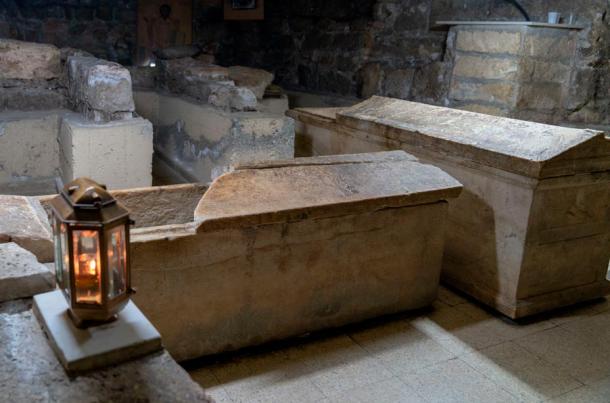
In 898, Emperor Leo VI asked that the remains of Lazarus’ body be transferred to the capital of his empire located in Constantinople. In exchange, he would build a church over the original tomb site in Larnaca. The church fathers of Larnaca well knew that a request from the Emperor was to be taken as an offer they could not refuse. So they agreed to the offer and the corpus of Lazareth was removed from its sarcophagus and sent to Constantinople. In 1204 the church in Larnaca built by the Emperor was renovated. The Alter Table was moved in order to access the marble sarcophagus that was said to be located directly under it. However, and much to everyone astonishment, when the sarcophagus was opened, there lay the undisturbed remains of Lazarus. This could only mean that the religious leaders of Larnaca had sent Emperor Leo VI a fake body and been rewarded with a church in which to house the real body of Lazarus. Meanwhile, as fate would have it, just before Constantinople fell to Islamic forces, the fake remains of Lazarus were said to have been sent to Marseille France to be stored for safe keeping. However, over time, the location of the body was forgotten. In 1972, the church in Larnaca underwent another complete renovation. At that time, the marble sarcophagus was once again found directly below the church’s alter. They opened the sarcophagus and once again found the actual remains of Lazareth. So apparently, Leo VI had been bamboozled and only the fake body of Lazarus was and continues to be lost.
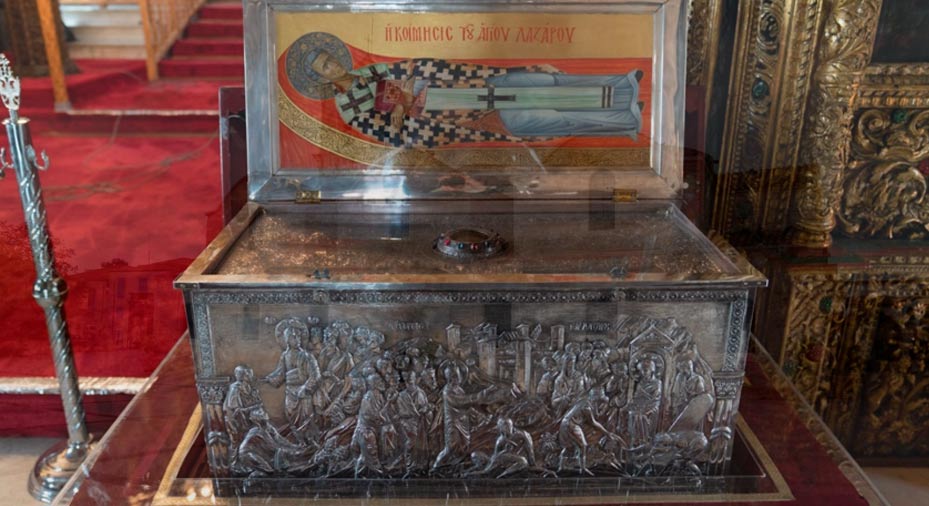
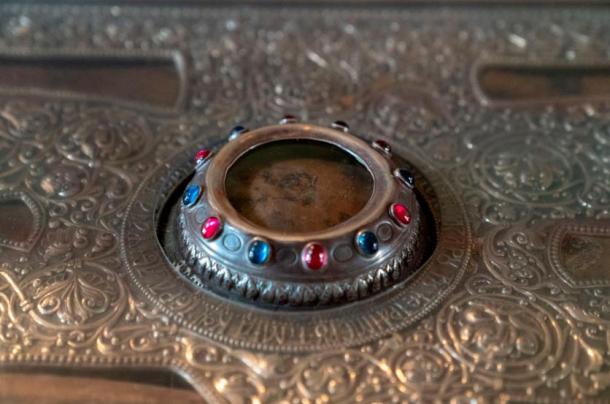
The first burial site of Lazarus from which Jesus raised him has been venerated since before the end of the first century and is located in the city of Bethany, Israel. The second and final burial site is located in the city of Larnaca, Cyprus. It was here that he fled with his sisters in order to escape the murder plot of the Chief Priests. Thus, ‘a tale of two cities’.
On a closing note, the family tomb of Caiaphas was discovered and excavated in 1990. His ossuary box was found and it still contained his skeletal remains. It was said by witnesses that when the box was first opened, a crucifixion nail was found among his bones. A second nail was also found lying on the tomb's floor. The nails were initially reported by Israeli authorities as having been misplaced but were later located and authenticated as being composed of first century Roman iron (Archeological Discovery Vol.8 No.3 July 2020). It is currently theorized that later in life, Caiaphas must have experienced serious misgivings about his hasty decision to have Jesus executed. Therefore, the nails he instructed to be put in his coffin and tomb must have served as superstitious amulets he secretly kept in life, and in death reflect a belated regret and prophetic warning. Caiaphas was giving an ominous notice from the gave to his fellow Jews that they too should seriously reconsider their position on Jesus as Messiah. Remarkable!
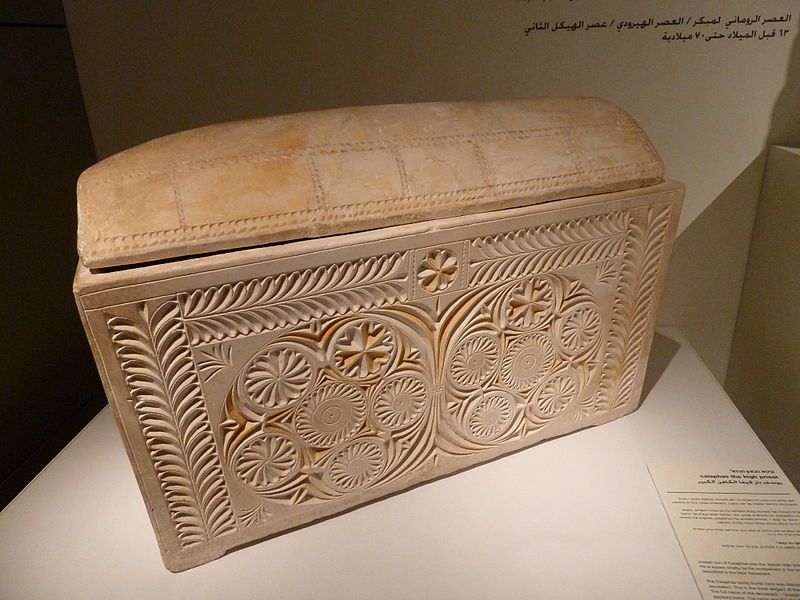
If you enjoy the information provided on this site, please consider making a donation of any amount to help continue its production. Donate Now